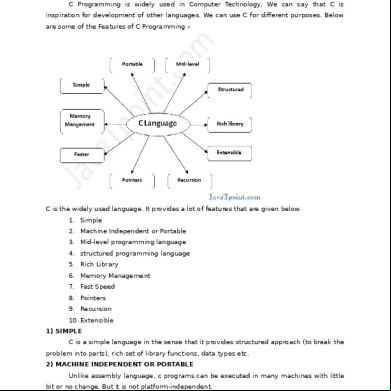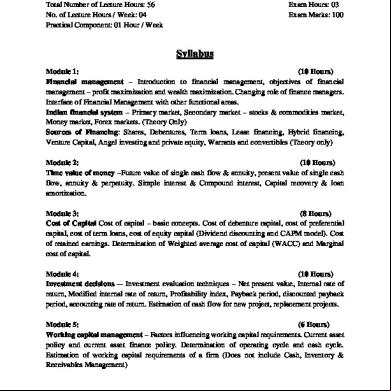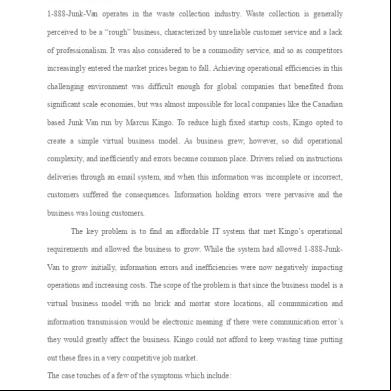Features Of C Language 2h4p5m
This document was ed by and they confirmed that they have the permission to share it. If you are author or own the copyright of this book, please report to us by using this report form. Report 3b7i
Overview 3e4r5l
& View Features Of C Language as PDF for free.
More details w3441
- Words: 1,183
- Pages: 6
FEATURES OF C LANGUAGE C Programming is widely used in Computer Technology, We can say that C is inspiration for development of other languages. We can use C for different purposes. Below are some of the Features of C Programming –
C is the widely used language. It provides a lot of features that are given below. 1. Simple 2. Machine Independent or Portable 3. Mid-level programming language 4. structured programming language 5. Rich Library 6. Memory Management 7. Fast Speed 8. Pointers 9. Recursion 10. Extensible 1) SIMPLE C is a simple language in the sense that it provides structured approach (to break the problem into parts), rich set of library functions, data types etc. 2) MACHINE INDEPENDENT OR PORTABLE Unlike assembly language, c programs can be executed in many machines with little bit or no change. But it is not platform-independent. 3) MID-LEVEL PRORGRAMMING LANGUAGE
C is also used to do low level programming. It is used to develop system applications such as kernel, driver etc. It also s the feature of high level language. That is why it is known as mid-level language. 4) STRUCTURED PRORGRAMMING LANGUAGE C is a structured programming language in the sense that we can break the program into parts using functions. So, it is easy to understand and modify. 5) RICH LIBRARY C provides a lot of inbuilt functions that makes the development fast. 6) MEMORY MANAGEMENT It s the feature of dynamic memory allocation. In C language, we can free the allocated memory at any time by calling the free () function. 7) SPEED The compilation and execution time of C language is fast. 8) POINTER C provides the feature of pointers. We can directly interact with the memory by using the pointers. We can use pointers for memory, structures, functions, array etc. 9) RECURSION In c, we can call the function within the function. It provides code reusability for every function. 10) EXTENSIBLE C language is extensible because it can easily adopt new features. APPLICATION OF C PROGRAMMING C Programming is best known programming language. C Programming is near to machine as well as human so it is called as Middle level Programming Language. C Programming can be used to do verity of tasks such as networking related, OS related. APPLICATION OF C PROGRAMMING ARE LISTED BELOW – 1. C language is used for creating computer applications 2. Used in writing Embedded softwares 3. Firmware for various electronics, industrial and communications products which use micro-controllers. 4. It is also used in developing verification software, test code, simulators etc. for various applications and hardware products. 5. For Creating Compiles of different Languages which can take input from other language and convert it into lower level machine dependent language. 6. C is used to implement different Operating System Operations. 7. UNIX kernel is completely developed in C Language.
BASIC STRUCTURE OF A C PROGRAM C language is very popular language among all the languages. Sometimes I think that had there been no "C" language there would have no C++ and even Java. So let me explain you
the
basic
structure
of
a
C
language.
The structure of a C program is a protocol (rules) to the programmer, while writing a C program. The general basic structure of C program is shown in the figure below. The whole program is controlled within main ( ) along with left brace denoted by “{” and right braces denoted by “}”. If you need to declare local variables and executable program structures are enclosed within “{” and “}” is called the body of the main function. The main ( ) function can be preceded by documentation, preprocessor statements and global declarations.
DOCUMENTATIONS The documentation section consist of a set of comment lines giving the name of the program, the another name and other details, which the programmer would like to use later. PREPROCESSOR STATEMENTS The preprocessor statement begin with # symbol and are also called the preprocessor directive. These statements instruct the compiler to include C preprocessors such as header files and symbolic constants before compiling the C program. Some of the preprocessor statements are listed below.
GLOBAL DECLARATIONS The variables are declared before the main ( ) function as well as defined functions are called global variables. These global variables can be accessed by all the defined functions including main ( ) function. The main ( ) function Each and Every C program should contain only one main ( ). The C program execution starts with main ( ) function. No C program is executed without the main function. The main ( ) function should be written in small (lowercase) letters and it should not be terminated by semicolon. Main ( ) executes defined program statements, library functions and defined functions and all these statements should be enclosed within left and right braces. Braces Every C program should have a pair of curly braces ({, }). The left braces indicates the beginning of the main ( ) function and the right braces indicates the end of the main ( ) function. These braces can also be used to indicate the -defined functions beginning and ending. These two braces can also be used in compound statements. Local Declarations The variable declaration is a part of C program and all the variables are used in main ( ) function should be declared in the local declaration section is called local variables. Not only variables, we can also declare arrays, functions, pointers etc. These variables can also be initialized with basic data types. For examples. Code: Main ( ) { int sum = 0; int x; float y; }
Here, the variable sum is declared as integer variable and it is initialized to zero. Other variables declared as int and float and these variables inside any function are called local variables. PROGRAM STATEMENTS These statements are building blocks of a program. They represent instructions to the computer to perform a specific task (operations). An instruction may contain an input-output statements, arithmetic statements, control statements, simple assignment statements and any other statements and it also includes comments that are enclosed within /* and */ . The comment statements are not compiled and executed and each executable statement should be terminated with semicolon. DEFINED FUNCTIONS These are subprograms, generally, a subprogram is a function and these functions are written by the are called ; defined functions. These functions are performed by specific tasks and this also contains set of program statements. They may be written before or after a main () function and called within main () function. This is an optional to the programmer. Now, let us write a small program to display some message shown below. CODE: # include <stdio.h> main() { printf ("welcome to the world of C/n"); } C PROGRAM EXAMPLE We are going to learn a simple “Hello World” program in this section. Functions, syntax and the basics of a C program are explained in below table.
OUTPUT: Hello World! Let us see the performance of above program line by line.
C is the widely used language. It provides a lot of features that are given below. 1. Simple 2. Machine Independent or Portable 3. Mid-level programming language 4. structured programming language 5. Rich Library 6. Memory Management 7. Fast Speed 8. Pointers 9. Recursion 10. Extensible 1) SIMPLE C is a simple language in the sense that it provides structured approach (to break the problem into parts), rich set of library functions, data types etc. 2) MACHINE INDEPENDENT OR PORTABLE Unlike assembly language, c programs can be executed in many machines with little bit or no change. But it is not platform-independent. 3) MID-LEVEL PRORGRAMMING LANGUAGE
C is also used to do low level programming. It is used to develop system applications such as kernel, driver etc. It also s the feature of high level language. That is why it is known as mid-level language. 4) STRUCTURED PRORGRAMMING LANGUAGE C is a structured programming language in the sense that we can break the program into parts using functions. So, it is easy to understand and modify. 5) RICH LIBRARY C provides a lot of inbuilt functions that makes the development fast. 6) MEMORY MANAGEMENT It s the feature of dynamic memory allocation. In C language, we can free the allocated memory at any time by calling the free () function. 7) SPEED The compilation and execution time of C language is fast. 8) POINTER C provides the feature of pointers. We can directly interact with the memory by using the pointers. We can use pointers for memory, structures, functions, array etc. 9) RECURSION In c, we can call the function within the function. It provides code reusability for every function. 10) EXTENSIBLE C language is extensible because it can easily adopt new features. APPLICATION OF C PROGRAMMING C Programming is best known programming language. C Programming is near to machine as well as human so it is called as Middle level Programming Language. C Programming can be used to do verity of tasks such as networking related, OS related. APPLICATION OF C PROGRAMMING ARE LISTED BELOW – 1. C language is used for creating computer applications 2. Used in writing Embedded softwares 3. Firmware for various electronics, industrial and communications products which use micro-controllers. 4. It is also used in developing verification software, test code, simulators etc. for various applications and hardware products. 5. For Creating Compiles of different Languages which can take input from other language and convert it into lower level machine dependent language. 6. C is used to implement different Operating System Operations. 7. UNIX kernel is completely developed in C Language.
BASIC STRUCTURE OF A C PROGRAM C language is very popular language among all the languages. Sometimes I think that had there been no "C" language there would have no C++ and even Java. So let me explain you
the
basic
structure
of
a
C
language.
The structure of a C program is a protocol (rules) to the programmer, while writing a C program. The general basic structure of C program is shown in the figure below. The whole program is controlled within main ( ) along with left brace denoted by “{” and right braces denoted by “}”. If you need to declare local variables and executable program structures are enclosed within “{” and “}” is called the body of the main function. The main ( ) function can be preceded by documentation, preprocessor statements and global declarations.
DOCUMENTATIONS The documentation section consist of a set of comment lines giving the name of the program, the another name and other details, which the programmer would like to use later. PREPROCESSOR STATEMENTS The preprocessor statement begin with # symbol and are also called the preprocessor directive. These statements instruct the compiler to include C preprocessors such as header files and symbolic constants before compiling the C program. Some of the preprocessor statements are listed below.
GLOBAL DECLARATIONS The variables are declared before the main ( ) function as well as defined functions are called global variables. These global variables can be accessed by all the defined functions including main ( ) function. The main ( ) function Each and Every C program should contain only one main ( ). The C program execution starts with main ( ) function. No C program is executed without the main function. The main ( ) function should be written in small (lowercase) letters and it should not be terminated by semicolon. Main ( ) executes defined program statements, library functions and defined functions and all these statements should be enclosed within left and right braces. Braces Every C program should have a pair of curly braces ({, }). The left braces indicates the beginning of the main ( ) function and the right braces indicates the end of the main ( ) function. These braces can also be used to indicate the -defined functions beginning and ending. These two braces can also be used in compound statements. Local Declarations The variable declaration is a part of C program and all the variables are used in main ( ) function should be declared in the local declaration section is called local variables. Not only variables, we can also declare arrays, functions, pointers etc. These variables can also be initialized with basic data types. For examples. Code: Main ( ) { int sum = 0; int x; float y; }
Here, the variable sum is declared as integer variable and it is initialized to zero. Other variables declared as int and float and these variables inside any function are called local variables. PROGRAM STATEMENTS These statements are building blocks of a program. They represent instructions to the computer to perform a specific task (operations). An instruction may contain an input-output statements, arithmetic statements, control statements, simple assignment statements and any other statements and it also includes comments that are enclosed within /* and */ . The comment statements are not compiled and executed and each executable statement should be terminated with semicolon. DEFINED FUNCTIONS These are subprograms, generally, a subprogram is a function and these functions are written by the are called ; defined functions. These functions are performed by specific tasks and this also contains set of program statements. They may be written before or after a main () function and called within main () function. This is an optional to the programmer. Now, let us write a small program to display some message shown below. CODE: # include <stdio.h> main() { printf ("welcome to the world of C/n"); } C PROGRAM EXAMPLE We are going to learn a simple “Hello World” program in this section. Functions, syntax and the basics of a C program are explained in below table.
OUTPUT: Hello World! Let us see the performance of above program line by line.











